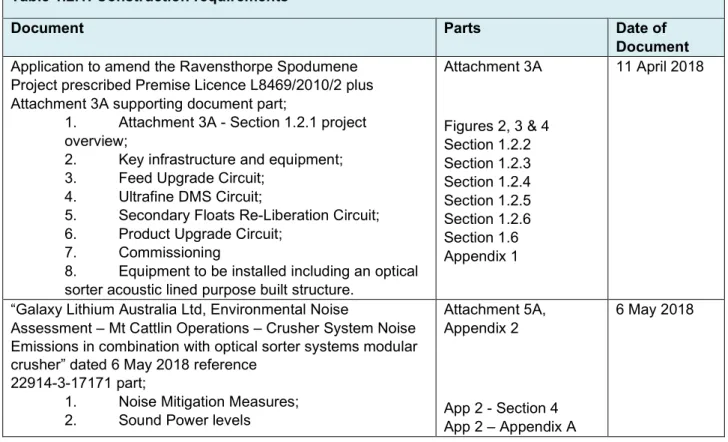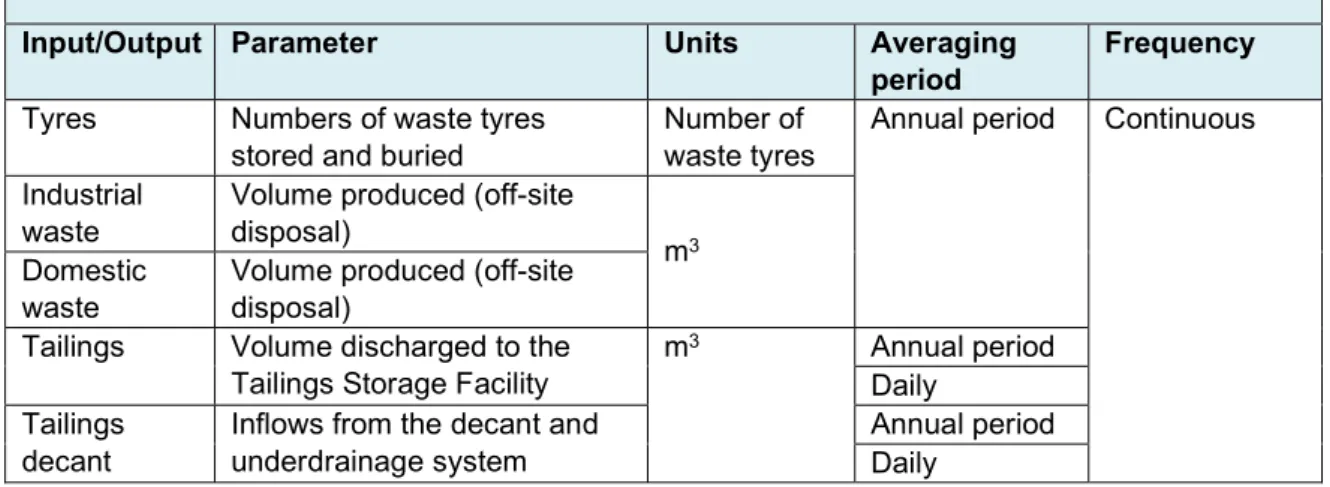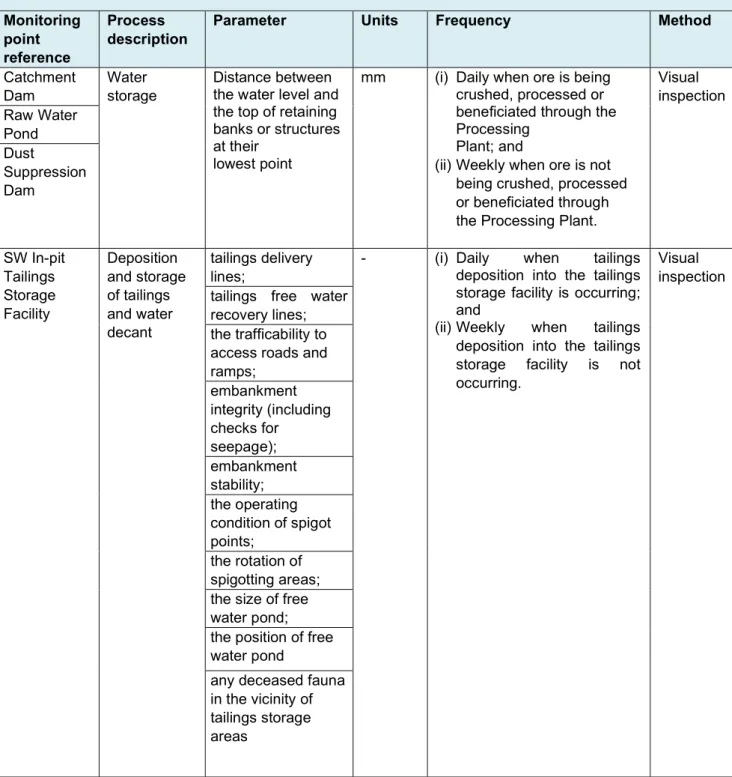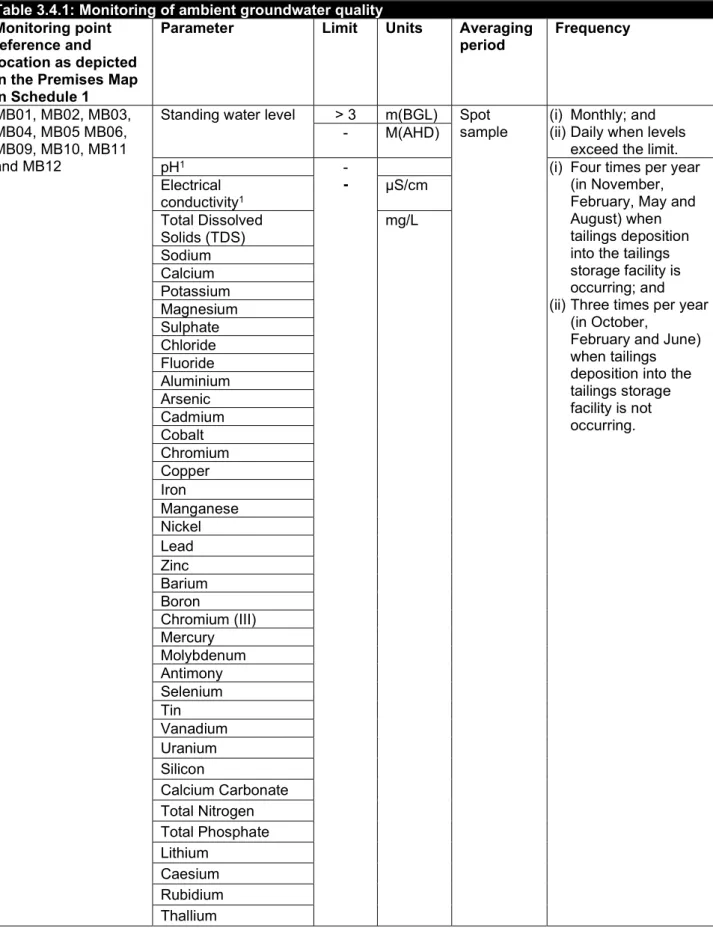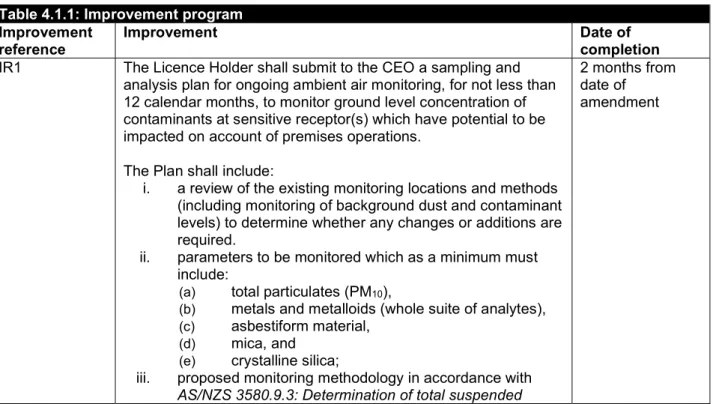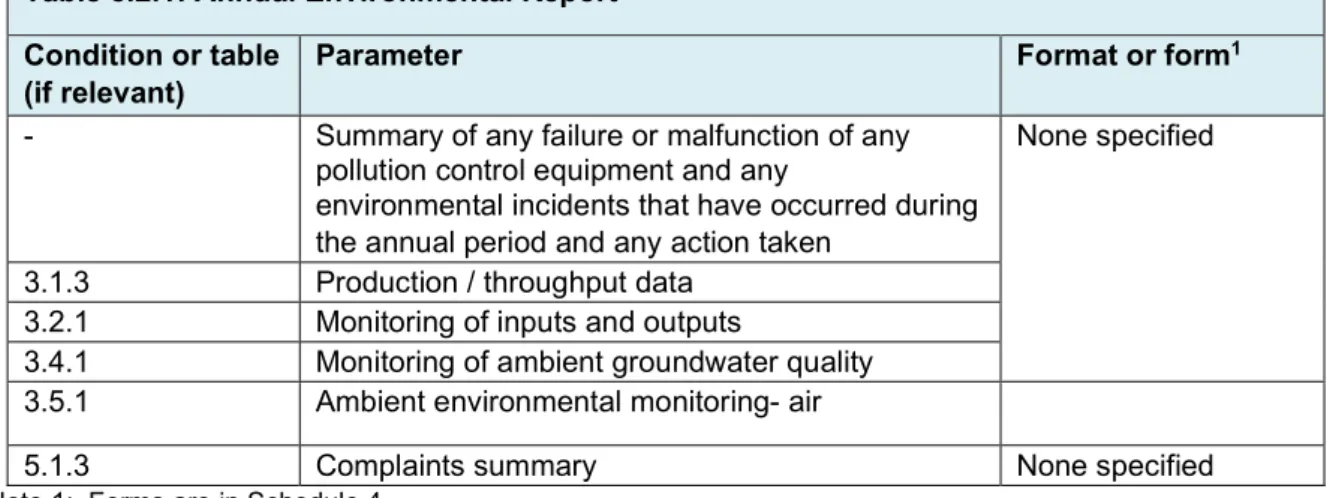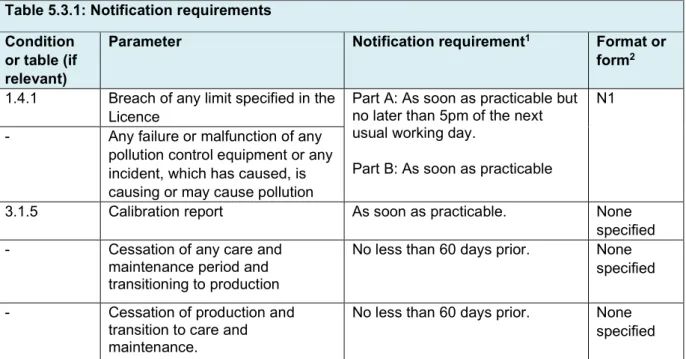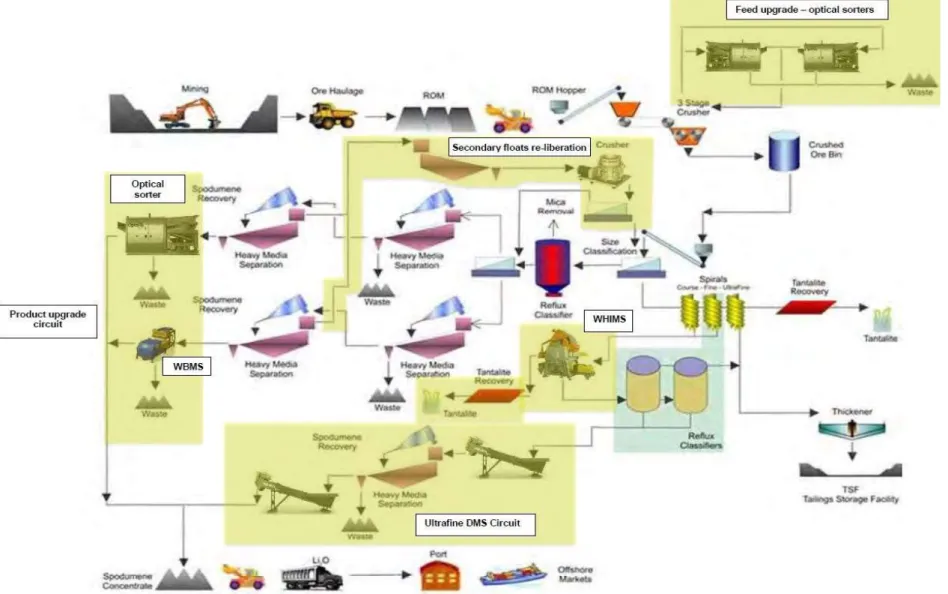Licence Number L8469/2010/2
Licence Holder Galaxy Lithium Australia Limited
ACN 130 182 099
Registered business address Level 4, 21 Kintail Road APPLECROSS WA 6953
File Number DER2014/001110-1
Duration 14/10/2013 to 13/10/2029
Date of amendment 30 June 2020
Prescribed Premises Category 5: Processing and beneficiation of metallic or nonmetallic ore
As defined in Schedule 3
Premises Ravensthorpe Spodumene Project Newdegate-Ravensthorpe Rd RAVENSTHORPE WA 6346
Lot 31 on Plan 224145 and Lot 127 on Plan 145763 (part of Mining Tenement M74/244)
As defined in Schedule 1
This Licence amendment is granted to the Licence Holder, subject to the following conditions, on 30 June 2020, by:
Rebecca Kelly
Senior Manager, Resource Industries
an officer delegated under section 20 of the Environmental Protection Act 1986 (WA)
Licence
Rebecca Kelly
Digitally signed by Rebecca Kelly Date: 2020.06.30 10:11:12 +08'00'
Contents
Contents 2
Introduction 2
Licence conditions 7
2 Emissions 13
3 Monitoring 14
4 Improvements 18
5 Information 19
Schedule 1: Maps 22
Schedule 2: Constructed infrastructure April 2018 26 Schedule 2: Constructed infrastructure April 2018 27 Schedule 2: Constructed infrastructure April 2018 28
Schedule 3: Prescribed Premises Categories 32
Schedule 4: Notification & Forms 33
Appendix 1: Diagram of Galaxy plant process April 2018 35 Appendix 2: Closest relevant sensitive receptors 37
Introduction
This Introduction is not part of the Licence conditions.
DWER’s industry licensing role
The Department of Water and Environmental Regulation (DWER) is a government
department for the state of Western Australia in the portfolio of the Minister for Environment.
DWER’s purpose is to advise on and implement strategies for a healthy environment for the benefit of all current and future Western Australians.
DWER has responsibilities under Part V of the Environmental Protection Act 1986 (the Act) for the licensing of prescribed premises. Through this process DWER works with the business owners, community, consultants, industry and other representatives to prevent, control and abate pollution and environmental harm to conserve and protect the
environment. DWER also monitors and audits compliance with works approvals and licence conditions, takes enforcement action as appropriate and develops and implements licensing and industry regulation policy.
Licence requirements
This Licence is issued under Part V of the Act. Conditions contained within the Licence relate to the prevention, reduction or control of emissions and discharges to the environment and to the monitoring and reporting of them.
Where other statutory instruments impose obligations on the Premises/Licensee the
intention is not to replicate them in the licence conditions. You should therefore ensure that you are aware of all your statutory obligations under the Act and any other statutory
instrument. Legislation can be accessed through the State Law Publisher website using the following link: http://www.slp.wa.gov.au/legislation/statutes.nsf/default.html
For your Premises relevant statutory instruments include but are not limited to obligations under the:
• Environmental Protection (Unauthorised Discharges) Regulations 2004 – these Regulations make it an offence to discharge certain materials such as contaminated stormwater into the environment other than in the circumstances set out in the Regulations.
• Environmental Protection (Controlled Waste) Regulations 2004 - these Regulations place obligations on you if you produce, accept, transport or dispose of controlled waste.
• Environmental Protection (Noise) Regulations 1997 – these Regulations require noise emissions from the Premises to comply with the assigned noise levels set out in the Regulations.
You must comply with your licence. Non-compliance with your licence is an offence and strict penalties exist for those who do not comply.
Licence holders are also reminded of the requirements of section 53 of the Act which places restrictions on making certain changes to prescribed premises unless the changes are in accordance with a works approval, licence, closure notice or environmental protection notice.
Licence fees
If you have a licence that is issued for more than one year, you are required to pay an annual licence fee prior to the anniversary date of issue of your licence. Non payment of annual licence fees will result in your licence ceasing to have effect meaning that it will no longer be valid and you will need to apply for a new licence for your Premises.
Ministerial conditions
If your Premises has been assessed under Part IV of the Act you may have had conditions imposed by the Minister for Environment. You are required to comply with any conditions imposed by the Minister.
Premises description and Licence summary
Galaxy Resources Limited (Galaxy) is licensed for a mining and processing facility for the production of spodumene a lithium aluminium silicate (LiAl(Si2O6), comprising (Li2O), and tantalum oxide (Ta2O5). The project is located at Mt Cattlin two kilometres northwest of the Ravensthorpe town site. The Ravensthorpe Spodumene Project has the capacity to extract 2,000,000 tonnes of ore per year to produce 300 kilotonnes per annum (ktpa) spodumene concentrate and 450 tonnes per annum (tpa) tantalite.
The premises commenced operation in October 2010, but placed into care and maintenance in July 2012. Since July 2012 the company retained their Part V licence to allow operations to recommence. Operations recommenced in 2016 and a number of licence amendments were granted to include new wet plant process infrastructure, upgrades and relocation of crushing and screening plant, and change of disposal method for their waste tailings.
Dewatering occurs on site and the water extracted is pumped to a storage pond for use in the process when the premises is operating. Dewatering continues while the premises is in care and maintenance, and water is also abstracted from monitoring bore MB03 due to a rising water level in this bore.
Power supply is from a diesel-fired power station. As the capacity is less than 10MW (max 6MW of power generated) it does not trigger the threshold for Category 52 prescribed premises under Schedule 1 of the EP Regs.
The infrastructure on the premises includes:
• open pit;
• waste rock dump;
• primary/spodumene concentrator;
• in-pit tailings storage facility (TSF) and associated pipelines;
• dust suppression dam;
• reverse osmosis plant (waste will be directed to the Raw/Process Water Pond);
• production bores;
• associated pipelines and storage pond, power station (5 MW diesel-fired);
• offices;
• workshop;
• stores;
• laboratory; and
• access roads.
Amendment June 2020
On 17 September 2019 the Licence Holder submitted an application for licence amendment to commence 24 hour mineral processing operations 7 days per week at the Ravensthorpe Spodumene Project. No increase in the premises production or design capacity is proposed.
No new infrastructure is proposed to be constructed on the premises. The scope of this Amendment includes assessment of potential environmental and public health impacts associated with proposed changes to premises operations. As part of the assessment, the Delegated Officer has also considered recommendations for licence amendment based on the findings of DWER’s environmental compliance inspection at the premises in December 2019 where these relate to management of emissions and discharges from ‘primary activities’ and ‘directly related activities’ as defined in DWER’s Guidance Statement: Risk Assessments (February 2017). The Licence Holder notified DWER on 4 March 2020 confirming that construction of embankment wall lift for TSF Cell1, authorised via
Amendment Notice 4 granted on 25 January 2019, will not proceed. The Licence has been amended to remove these redundant conditions.
Amendment to the type and style of the licence has been undertaken and a revised licence consolidating changes made under Amendment Notices issued between 2016 to 2019 (as detailed in the instrument log below), where relevant has been granted. In consolidating the licence, the CEO has:
updated the format and appearance of the Licence;
deleted the redundant AACR form set out in schedule 1 of the previous licence and advise the Licence Holder to obtain the form from the Department’s website;
revised licence condition numbers, and removed any redundant conditions and realigned condition numbers for numerical consistency; and
corrected clerical mistakes and minor errors.
The licences and works approvals issued for the Premises since 19/06/2009 are:
Instrument log
Instrument Issued Description
W4533/2009/1 19/06/2009 New works approval for premises construction W4533/2009/1 8/07/2010 Works approval amendment (removal of Phase 2) W4533/2009/1 11/10/2010 Works approval amendment (removal of spill trays under
conveyors)
L8469/2010/1 14/10/2010 New licence issued for premises operation
L8469/2010/1 7/07/2011 Licence amendment (noise management requirements) L8469/2010/1 24/05/2012 Licence amendment (TSF manual revision)
W4533/2009/1 24/05/2012 Works approval amendment (extension to expiry for TSF lifts) W4533/2009/1 17/01/2013 Works approval amendment (reflux classifier)
L8469/2010/2 3/10/2013 Licence reissue
L8469/2010/2 4/09/2014 Licence amendment (groundwater management and conversion to latest DER licence format).
L8469/2010/1 29/04/2016 Amendment Notice 1: Department initiated amendment in accordance with section 59(1)(k) of the Environmental Protection Act 1986 to amend the duration of the licence date month year.
L8469/2010/2 2/6/2016 Licence amendment application to include construction of temporary tailings stockpile area and inclusion of Reflux clarifiers and Lithium Belt Filter into the process plant circuit.
L8469/2010/2 27/03/2018 Amendment Notice 2: an application for licence amendment was made on 15 May 2017 to confirm upgrades to the wet process plant and the repaired Tailings
Storage Facility (TSF) plus addition of two mobile crushing and screening plants and, an increased production capacity for category 5 activities up to 1,600,000 tonnes per annum (tpa).
L8469/2010/2 20/06/2018 Amendment Notice 3: an application for licence amendment was made on 12 April 2018 to upgrade to the process plant and the modular screening plant resulting in an increased
production capacity for category 5 activities up to 2.0 Million tonnes per annum (Mtpa).
L8469/2010/2 25/01/2019 Amendment Notice 4: an application for licence amendment was made on 18 October 2018 to TSF cell 1 wall lift 3 to final RL height of 280.3m.
L8469/2010/2 08/04/2019 Amendment Notice 5: an application for licence amendment was made on 15 January 2019 to include relocation of Optical Sorter onto ROM pad inclusion of modular two stage crusher and 6m high acoustics barrier.
L8469/2010/2 03/07/2019 Amendment Notice 6: an application for licence amendment was made on 15 February 2019 to construct infrastructure and operate tailings waste deposition into disused mine void referred to as SW Pit.
L8469/2010/2 30/6/ 2020 This amendment. Authorising 24x7 operations of Category 5 processing infrastructure at the premises. Consolidation of previous amendment notice conditions. Deletion of redundant conditions pursuant to Amendment Notice 4 based on Licence Holder’s notification that TSF Cell 1 embankment lift will not proceed because the above-ground TSF has been
decommissioned.
Severance
It is the intent of these Licence conditions that they shall operate so that, if a condition or a part of a condition is beyond the power of this Licence to impose, or is otherwise ultra vires or invalid, that condition or part of a condition shall be severed and the remainder of these conditions shall nevertheless be valid to the extent that they are within the power of this Licence to impose and are not otherwise ultra vires or invalid.
END OF INTRODUCTION
Licence conditions
1 General
1.1 Interpretation
1.1.1 In the Licence, definitions from the Environmental Protection Act 1986 apply unless the contrary intention appears.
1.1.2 For the purposes of this Licence, unless the contrary intention appears:
‘AACR’ means Annual Audit Compliance Report, a report in a format approved by the CEO as presented by the Licence Holder or as specified by the CEO from time to time and published on the Department’s website and a copy of the AACR form is accessible from the DWER website;
‘Act’ means the Environmental Protection Act 1986;
‘AHD’ means the Australian height datum;
‘Amended Licence’ means this decision to amend the licence L8469/2010/2 granted on 30 June 2020;
‘AMMP’ means the most recent version of the Galaxy document titled “Airborne Materials Management Plan”;
‘Annual Period’ means the inclusive period from 1 September until 31 August in the following year;
‘applicable standards and guidelines’ means but is not limited to the following documents:
- Department of Environment and Conservation, Contaminated Sites Management Series guideline ‘Assessment Levels for Soil, Sediment and Water’ (February 2010), as amended from time to time. If relevant assessment levels are not included in this guideline, alternative assessment levels should be adopted from appropriate Australian and/or International guidance documents to enable an adequate assessment of the data; and
- Australian and New Zealand Environment and Conservation Council and the Agriculture and Resource Management Council of Australia and New Zealand
‘Australian and New Zealand Guidelines for Fresh and Marine Water Quality’
(October, 2000), as amended from time to time.
‘AS/NZS 5667.1’ means the Australian Standard AS/NZS 5667.1 Water Quality – Sampling – Guidance of the Design of sampling programs, sampling techniques and the preservation and handling of samples;
‘AS/NZS 5667.11’ means the Australian Standard AS/NZS 5667.11 Water Quality – Sampling – Guidance on sampling of groundwaters;
‘averaging period’ means the time over which a limit or target is measured or a monitoring result is obtained;
‘BGL’ means below ground level;
‘broadband style reversing alarms’ means reversing alarms that generate a warning signal consisting of a wide range of frequencies that automatically adjusts its output depending on local noise levels;
‘care and maintenance’ means the state of operating the premises when ore is not being crushed, processed or beneficiated through the Processing Plant; however infrastructure on site may still be maintained in suitable condition to enable processing to re-commence when required;
‘catchment dam’ means the dam receiving stormwater runoff from the processing plant area, as depicted and labelled ‘catchment dam’ on the Premises Map in Schedule 1;
‘CEMS’ means continuous emissions monitoring system;
‘CEO’ means Chief Executive Officer of the Department of Water and Environmental Regulation;
‘CEO’ for the purpose of correspondence means:
Chief Executive Officer
Department Administering the Environmental Protection Act 1986 Locked Bag 10
JOONDALUP DC WA 6027 Telephone: (08) 6367 7000 Facsimile: (08) 6367 7001 Email: [email protected]
‘Compliance Report’ means a report in a format approved by the CEO as presented by the Licence Holder or as specified by the CEO from Time to time and published on the Departments website;
‘controlled waste’ has the definition in Environmental Protection (Controlled Waste) Regulations 2004;
‘DMIRS’ means Department of Mines, Industry Regulation and Safety;
‘DMS’ means ultrafine Dense Mass Separation (DMS) process plant circuit to recover finer fractions of Spodumene;
‘dust suppression dam’ means the dam storing water for the suppression of dust on site, as depicted and labelled ‘Dust Suppression Dam’ on the Premises Map in Schedule 1;
‘EP Act’ means Environmental Protection Act 1986;
‘freeboard’ means the distance between the maximum water surface elevations and the top of retaining banks or structures at their lowest point;
‘GL/yr’ means Gigalitres per year;
‘level ground’ means ground that is not inclined at a grade of more than 1 in 20;
‘Licence’ means this Licence numbered L8469/2010/2 and issued under the Act;
‘Licence Holder’ means Galaxy Lithium Australia Limited;
‘m3’ means cubic meters;
‘mbgl’ means metres below ground level;
‘mg/L’ means milligrams per litre;
‘monitoring bores’ means the groundwater monitoring bores on the premises as depicted and labelled ‘MB01’, ‘MB02’, ‘MB03’, ‘MB04’, ‘MB05’ and ‘MB06’ on the Premises Map in Schedule 1;
‘Mtpa’ means million tonnes per annum;
‘NATA’ means the National Association of Testing Authorities, Australia;
‘NATA accredited’ means in relation to the analysis of a sample that the laboratory is NATA accredited for the specified analysis at the time of the analysis;
‘night’ means between the hours of 2200 hours on any day to 0700 hours Monday to Saturday and 0900 hours on Sunday’s or Public holidays;
‘ONMP’ means the Operational Noise Management Plan (2016) revision 5 dated 12 July 2017 reference 12843-5-10196;
‘or equivalent’ means a model of machinery with equivalent or lower sound power levels than the model specified;
‘Premises’ means the area defined in the Premises Map in Schedule 1 and listed as the Premises address on page 1 of the Licence;
‘processing plant’ means the infrastructure related to the crushing, processing and/or beneficiation of the ore including the wet crushing circuit, wet plant and ROM pad as depicted and labelled in the Premises Map in Schedule 1;
‘raw water pond’ means the pond containing water for use in the processing plant, as depicted and labelled ‘Raw water pond’ on the Premises Map in Schedule 1;
‘RL’ means Relative Level and is the height or elevation above a survey point adopted as the site datum for the purpose of establishing levels;
‘ROM pad’ means the run of mine stockpile area, as depicted and labelled ‘ROM pad’ on the Premises Map in Schedule 1;
‘Schedule 1’ means Schedule 1 of this Licence unless otherwise stated;
‘Schedule 2’ means Schedule 2 of this Licence unless otherwise stated;
‘spot sample’ means a discrete sample representative at the time and place at which the sample is taken;
‘TSF Operating Manual’ means Mt Cattlin Project Tailings Storage Facility Stage 1 Operating Manual (Galaxy Resources August 2010, as amended 24 April 2012);
‘Unit 1’ means the “Mobile crushing plant installation area” as indicated in Schedule 2;
‘Unit 2’ means the “Yield Optimisation Project Area” as indicated in Schedule 2;
‘usual working day’ means 0800 – 1700 hours, Monday to Friday excluding public holidays in Western Australia; and
‘µS/cm’ means microsiemens per centimetre;
1.1.3 Any reference to an Australian or other standard in the Licence means the relevant parts of the standard in force from time to time during the term of this Licence.
1.1.4 Any reference to a guideline or code of practice in the Licence means the version of that guideline or code of practice in force from time to time, and shall include any amendments or replacements to that guideline or code of practice made during the term of this Licence.
1.2 Premises operation
1.2.1 The Licence Holder must record and investigate the exceedance of any descriptive or numerical limit or target specified in any part of section 1 of this Licence.
1.2.2 The Licence Holder must maintain a minimum freeboard of 300 millimetres at all times in the catchment dam, the raw water dam, and the dust suppression dams.
1.2.3 The Licence Holder must ensure that water in the Catchment Dam, the Raw Water Dam and the Dust Suppression Dam (s) is reused for dust suppression, processing and/or is retained in the ponds to evaporate so discharges from these ponds to the environment do not occur.
1.2.4 The Licence Holder must ensure that standing water levels in all Tailing Storage Facility (TSF) monitoring bores remain greater than three metres below ground level.
1.2.5 The Licence Holder must:
(a) ensure that no more than twenty five (25) tyres are stored at any one time at any location awaiting final disposal via burial at the Waste Dump;
(b) ensure that tyres are only stacked on level ground; and (c) ensure that all tyres are stacked on their side walls.
1.2.6 The Licence Holder must:
(a) ensure that tyres are not buried in any location on the premises other than the Waste Dump area;
(b) place a final cover of at least 500 millimetres depth over tyres buried at the premises;
(c) bury tyres laid flat on their side walls, separated in all directions by a minimum of 30cm and with voids and surrounds filled with suitable competent material;
(d) ensure buried tyres are located a minimum of two metres from any final out slope of the final waste dump profile;
(e) not dispose of any burnt tyres (or that appear burnt) at the premises; and (f) not ignite any tyres on the premises.
1.2.7 The Licence Holder must ensure that pipelines containing tailings and product have either:
(a) secondary containment sufficient to contain any spill for a period equal to the time between routine inspections; or
(b) equipped with telemetry systems and pressure sensors along pipelines to allow the detection of leaks and failures; or
(c) equipped with automatic cut-outs in the event of a pipe failure.
1.2.8 The Licence Holder must maintain the 6m high and 40m long ROM noise barrier in the location as indicated in Schedule 2 plan titled “Location of 6m high Noise Barrier on the ROM pad”.
1.2.9 The Licence Holder must install ROM optical sorter circuit, ROM 6 metres high noise barrier and ROM two stage crusher circuit in the location as indicated in Schedule 2 plan titled “ROM two stage crushing and optical sorter circuit plus 6 metre high noise barrier”.
1.2.10 The Licence Holder must ensure the ROM optical sorter circuit and ROM two stage crusher circuit are located on the ROM pad on the southern side of the ROM 6 metre noise barrier.
1.2.11 The Licence Holder must complete an upgrade of the modular crusher (Unit 1) and the process plant (Unit 2) in accordance with the documentation listed in Table 1.2.1 and in the location depicted in Schedule 2 titled “Constructed Infrastructure April 2018”.
Table 1.2.1: Construction requirements1
Document Parts Date of
Document Application to amend the Ravensthorpe Spodumene
Project prescribed Premise Licence L8469/2010/2 plus Attachment 3A supporting document part;
1. Attachment 3A - Section 1.2.1 project overview;
2. Key infrastructure and equipment;
3. Feed Upgrade Circuit;
4. Ultrafine DMS Circuit;
5. Secondary Floats Re-Liberation Circuit;
6. Product Upgrade Circuit;
7. Commissioning
8. Equipment to be installed including an optical sorter acoustic lined purpose built structure.
Attachment 3A
Figures 2, 3 & 4 Section 1.2.2 Section 1.2.3 Section 1.2.4 Section 1.2.5 Section 1.2.6 Section 1.6 Appendix 1
11 April 2018
“Galaxy Lithium Australia Ltd, Environmental Noise
Assessment – Mt Cattlin Operations – Crusher System Noise Emissions in combination with optical sorter systems modular crusher” dated 6 May 2018 reference
22914-3-17171 part;
1. Noise Mitigation Measures;
2. Sound Power levels
Attachment 5A, Appendix 2
App 2 - Section 4 App 2 – Appendix A
6 May 2018
1.2.12 The Licence Holder must complete installation of ROM optical sorter circuit, ROM 6 metres high noise barrier and ROM two stage crusher circuit in accordance with the documentation listed in Table 1.2.2 and in the location depicted in Schedule 2 titled
“ROM two stage crushing and optical sorter circuit plus 6 metre high noise barrier”.
Table 1.2.2: Construction requirements
Document Parts Date of
Document Galaxy Lithium Australia Limited: DWER Licence Amendment
Application Attachment 3A by Tetris Environmental dated 15 January 2019
1.2.2 Key Infrastructure
Optical Sorter, Two stage Crusher & 6m high 40m long noise barrier
1.2.3 Feed Upgrade Circuit 1.5 Construction
1.6 Commissioning and Operation 1.6.6 Commissioning Report 1.6.7 Responsibilities
Application to amend the Ravensthorpe Spodumene Project prescribed Premise Licence L8469/2010/2 plus Attachment 3A supporting document part;
Attachment 3A
Section 1.2.2
Section 1.2.3 Section 1.5 Section 1.6 Section 1.6.6 Section 1.6.7 Attachment 3A
January 2019
11 April 2018
1. Equipment to be installed including optical sorter acoustic lined purpose built structure
Appendix 1 Galaxy Lithium Australia Limited: Environmental Noise
Assessment Mt Cattlin Operations, Crusher/Process system noise emissions in combination with ROM Crusher/Optical Sorter System by Herring Storer Acoustics dated January 2019 – reference 23882-4-18251
Appendix B – 6m high 40m long Acoustic Barrier Map reference 16219 Run 4704B
Appendix B
16219 run 4704B
January 2019
1.2.13 The Licence Holder must notify the CEO in writing no less than 7 days prior to commencing operation of the crushing screening infrastructure, including the ROM Optical Sorter and any ancillary infrastructure, between 7.00pm and 7.00 am.
1.2.14 The Licence Holder may operate the crushing screening infrastructure including the ROM Optical Sorter and any ancillary infrastructure, between 7.00pm and 7.00am as required, for a period not exceeding 8 months from the date of commencement, as included in the notification pursuant to Condition 1.2.13.
1.2.15 The Licence Holder must ensure that noise attenuation infrastructure (such as engineered noise barriers) is constructed and maintained to ensure compliance with the requirements of the Environmental Protection (Noise) Regulations 1997 at all times.
2 Emissions
2.1 Fugitive emissions
2.1.1 The Licence Holder must take the following measures with regards to dust emissions from all activities on site:
(a) maintain all dust suppression systems on conveyors, screens and crushers and ensure they are in working order at all times during operation;
(b) maintain water trucks on site so that they are available at all times to implement dust suppression on site roads, the ROM pad and the open pit;
and
(c) restrict traffic speeds on the Premises to reduce the risk of dust generation 2.1.2 The Licence Holder must undertake the fugitive dust management requirements in
Table 2.1.1.
Table 2.1.1: Fugitive dust management requirements Activity Operation details requirements Water and Dust
suppressants
Operate proactively subject to weather forecasting over a 24 hour period.
Reduce the scope of activity or halt the activity should receptors be impacted.
Cessation of activities Cease an activity causing visible dust lift-off where dust management measures have not prevented dust lift-off and there is a risk of dust affecting sensitive external receptors (residences).
3 Monitoring
3.1 General monitoring
3.1.1 The Licence Holder must ensure that:
(a) all water samples are collected and preserved in accordance with AS/NZS 5667.1;
(b) all groundwater sampling is conducted in accordance with AS/NZS 5667.11; and
(c) all laboratory samples are submitted to and tested by a laboratory with current NATA accreditation for the parameters being measured unless indicated otherwise in the relevant table.
3.1.2 The Licence Holder must ensure that:
(a) monthly monitoring is undertaken at least 15 days apart;
and
(b) annual monitoring is undertaken at least 9 months apart.
3.1.3 The Licence Holder must record production or throughput data and any other process parameters relevant to any non-continuous or CEMS monitoring undertaken.
3.1.4 The Licence Holder must ensure that all monitoring equipment used on the Premises to comply with the conditions of this Licence is calibrated in accordance with the manufacturer’s specifications.
3.1.5 The Licence Holder must, where the requirements for calibration cannot be practicably met, or a discrepancy exists in the interpretation of the requirements, bring these issues to the attention of the CEO accompanied with a report
comprising details of any modifications to the methods.
3.2 Monitoring of inputs and outputs
3.2.1 The Licence Holder must undertake the monitoring in Table 3.2.1 according to the specifications in that table.
Table 3.2.1: Monitoring of inputs and outputs
Input/Output Parameter Units Averaging period
Frequency Tyres Numbers of waste tyres
stored and buried
Number of waste tyres
Annual period Continuous Industrial
waste
Volume produced (off-site
disposal) m3
Domestic waste
Volume produced (off-site disposal)
Tailings Volume discharged to the Tailings Storage Facility
m3 Annual period Daily
Tailings decant
Inflows from the decant and underdrainage system
Annual period Daily
3.3 Process monitoring
3.3.1 The Licence Holder must undertake the monitoring in Table 3.3.1 according to the specifications in that table.
Table 3.3.1: Process monitoring Monitoring
point reference
Process description
Parameter Units
Frequency Method
Catchment Dam
Water storage
Distance between the water level and the top of retaining banks or structures at their
lowest point
mm (i) Daily when ore is being crushed, processed or beneficiated through the Processing
Plant; and
(ii) Weekly when ore is not being crushed, processed or beneficiated through the Processing Plant.
Visual inspection Raw Water
Pond Dust
Suppression Dam
SW In-pit Tailings Storage Facility
Deposition and storage of tailings and water decant
tailings delivery lines;
- (i) Daily when tailings deposition into the tailings storage facility is occurring;
and
(ii) Weekly when tailings deposition into the tailings storage facility is not occurring.
Visual inspection tailings free water
recovery lines;
the trafficability to access roads and ramps;
embankment integrity (including checks for
seepage);
embankment stability;
the operating condition of spigot points;
the rotation of spigotting areas;
the size of free water pond;
the position of free water pond
any deceased fauna in the vicinity of tailings storage areas
3.3.2 The Licence Holder must ensure that the operational freeboard in SW In-pit Tailings Storage Facility is at least 2 metres below the lowest part of SW Pit crest.
3.3.3 The Licence Holder must ensure that the SW In-pit TSF perimeter bund is maintained to divert stormwater away from the pit.
3.4 Ambient environmental quality monitoring – Groundwater quality
3.4.1 The Licence Holder must undertake the monitoring in Table 3.4.1 according to the specifications in that table and record and investigate results that do not meet any limit specified.
Table 3.4.1: Monitoring of ambient groundwater quality Monitoring point
reference and location as depicted in the Premises Map in Schedule 1
Parameter Limit Units Averaging
period Frequency
MB01, MB02, MB03, MB04, MB05 MB06, MB09, MB10, MB11 and MB12
Standing water level > 3 m(BGL) Spot
sample (i) Monthly; and (ii) Daily when levels
exceed the limit.
- M(AHD)
pH1 -
- (i) Four times per year
(in November, February, May and August) when tailings deposition into the tailings storage facility is occurring; and (ii) Three times per year
(in October,
February and June) when tailings deposition into the tailings storage facility is not occurring.
Electrical
conductivity1 µS/cm
Total Dissolved
Solids (TDS) mg/L
Sodium Calcium Potassium Magnesium Sulphate Chloride Fluoride Aluminium Arsenic Cadmium Cobalt Chromium Copper Iron
Manganese Nickel Lead Zinc Barium Boron
Chromium (III) Mercury Molybdenum Antimony Selenium Tin Vanadium Uranium Silicon
Calcium Carbonate Total Nitrogen Total Phosphate Lithium
Caesium Rubidium Thallium
Bromide Gross-alpha
Bq/L Gross-beta
Note 1: In-field non-NATA accredited analysis permitted.
3.4.2 Upon becoming aware of any exceedance of the standing water level limit in Table 3.4.1, the Licence Holder must implement increased frequency of groundwater level monitoring and continual assessment as outlined in the TSF Operating Manual.
3.5 Ambient environmental monitoring
3.5.1 The Licence Holder must undertake the monitoring in Tables 3.5.1 according to the specifications in that table and record and investigate results that do not meet any target specified.
Table 3.5.1: Monitoring of ambient air quality Monitoring point
reference
Parameter Limit Method Units Averaging period
Frequency Dust Deposition
Gauge (DDG1 through to DDG5, DDG7, DDG8, DDG9, DDG10) located as depicted in the Schedule 1:
Map 3 titled Baseline Dust Monitoring Locations
Deposited dust -- AS/NZS
3580.10.1 g/m2/month Monthly Continuous for the duration of each sampling period
DDG8, DDG9, DDG10 and DDG201
Characterisation of deposited minerals on dust deposition gauges
-- Scanning electron microscopy or
equivalent NATA accredited method
-- Monthly Quarterly
Ravensthorpe town
site Hi-Vol monitor PM10 50 AS/NZS
3580.9.6 µg/m3 24 hours One day in six day period Note 1: DDG20 is the background dust deposition gauge
3.6 Specified actions- Noise verification monitoring- night time operations (1900 hours to 0700 hours)
3.6.1 Within 30 days of the commencement date of the night time operations, the licence holder must retain the services of a person qualified and experienced in the area of environmental noise assessment and who by their qualifications and experience is eligible to hold membership of the Australian Acoustical Society or the Australian Association of Acoustical Consultants to:
(a) investigate the nature and extent of noise emissions from the premises during night time operations;
(b) assess in accordance with the methodology required in the Environmental Protection (Noise) Regulations 1997, the compliance of the noise emissions
from the primary activities, against the relevant assigned levels specified in those Regulations; and
(c) compile and submit to the licence holder a report in accordance with condition 3.6.2.
3.6.2 A report prepared pursuant to condition 3.6.1(c) must include:
(a) a description of the methods used for monitoring and/or modelling of noise emissions from the premises;
(b) details and the results of the investigation undertaken pursuant to condition 3.6.1(a);
(c) details and results of the assessment of the noise emissions from the premises, against the relevant assigned levels in the Environmental Protection (Noise) Regulations 1997 undertaken pursuant to condition 3.6.1(b);
(d) an assessment of monitored noise levels against the most recent noise modelling assessment; and
(e) recommendations for ongoing noise monitoring to assess compliance against the assigned levels in the Environmental Protection (Noise) Regulations 1997 and recommendations/criteria proposed for review of noise modelling assessment.
3.6.3 The licence holder must submit to the CEO the report prepared pursuant to condition 3.6.1(c) no later than 60 days from the date of commencement of night time operations as notified to the CEO pursuant to Condition 1.2.13.
4 Improvements
4.1 Improvement program
4.1.1 The Licence Holder must complete the improvements in Table 4.1.1 by the date of completion in Table 4.1.1.
Table 4.1.1: Improvement program Improvement
reference Improvement Date of
completion IR1 The Licence Holder shall submit to the CEO a sampling and
analysis plan for ongoing ambient air monitoring, for not less than 12 calendar months, to monitor ground level concentration of contaminants at sensitive receptor(s) which have potential to be impacted on account of premises operations.
The Plan shall include:
i. a review of the existing monitoring locations and methods (including monitoring of background dust and contaminant levels) to determine whether any changes or additions are required.
ii. parameters to be monitored which as a minimum must include:
(a) total particulates (PM10),
(b) metals and metalloids (whole suite of analytes), (c) asbestiform material,
(d) mica, and (e) crystalline silica;
iii. proposed monitoring methodology in accordance with AS/NZS 3580.9.3: Determination of total suspended
2 months from date of amendment
particulates: High volume sampler gravimetric method and detection limit for each parameter being monitored;
iv. sampling methodology proposed including details of any quality assurance/ quality control procedures which will be established;
v. proposed duration of each sampling event and justification for the same;
vi. proposed analysis frequency and justification for the same;
vii. a plan for commencing the ongoing ambient air monitoring, prior to commencing night time operations, and no later than three months from the sampling and analysis plan being submitted.
IR2 The Licence Holder must undertake review of contaminated stormwater management infrastructure on the premises and any improvement measures required to ensure there is no discharge from the premises into Cattlin Creek and submit a report to the CEO. The report must include:
i. identification of any additional infrastructure or operational controls required to prevent discharge into the
environment; and
ii. proposed schedule for completing any improvement measures identified.
6 months from date of amendment
5 Information
5.1 Records
5.1.1 All information and records required by the Licence must:
(a) be legible;
(b) if amended, be amended in such a way that the original and subsequent amendments remain legible or are capable of retrieval;
(c) except for records listed in 5.1.1(d) be retained for at least 6 years from the date the records were made or until the expiry of the Licence or any
subsequent licence; and
(d) for those following records, be retained until the expiry of the Licence and any subsequent licence:
(i) off-site environmental effects; or
(ii) matters which affect the condition of the land or waters.
5.1.2 The Licence Holder must submit to the CEO within 60 calendar days after the end of the annual period a Compliance Report indicating the extent to which the Licence Holder has complied with the conditions in this Licence for the annual period.
5.1.3 The Licence Holder must implement a complaints management system that as a minimum records the number and details of complaints received concerning the environmental impact of the activities undertaken at the Premises and any action taken in response to the complaint.
5.1.4 The Licence Holder must maintain inspection log book/s on site in which each inspection undertaken in accordance with Condition 3.3.1 Table 3.3.1 is logged and comments made on observations at the time of inspection.
5.1.5 The Licence Holder must submit a compliance document to the CEO within one month following the completion of the works under condition 1.2.11 as described in Table 1.2.1.
5.1.6 The Licence Holder must within 30 days of each item of infrastructure required by condition0 and Table 1.2.2 being constructed:
a) undertake an audit of their compliance with the requirements of condition 0; and
b) prepare and submit to the CEO an audit report of that compliance.
5.1.7 The audit report required by condition 5.1.6, must:
(a) be certified by the supervising engineer that each item of infrastructure listed in Table 1.2.2 meets the corresponding specifications and at the locations set out in Table 1.2.2 and has been constructed with no material defects;
(b) contain an ‘as constructed plan’ for the works that show the infrastructure;
(c) be signed by a person authorised to represent the licence holder with the printed name and position of that person within the company; and, (d) include a commissioning report demonstrating that the infrastructure
operates as designed.
5.2 Reporting
5.2.1 The Licence Holder must submit to the CEO an Annual Environmental Report within 60 calendar days after the end of the annual period. The report shall contain the information listed in Table 5.2.1 in the format or form specified in that table.
Table 5.2.1: Annual Environmental Report Condition or table
(if relevant)
Parameter Format or form1
- Summary of any failure or malfunction of any
pollution control equipment and any
environmental incidents that have occurred during the annual period and any action taken
None specified
3.1.3 Production / throughput data 3.2.1 Monitoring of inputs and outputs
3.4.1 Monitoring of ambient groundwater quality 3.5.1 Ambient environmental monitoring- air
5.1.3 Complaints summary None specified
Note 1: Forms are in Schedule 4
5.2.2 The Licence Holder must ensure that the Annual Environmental Report also contains:
(a) any relevant process, production or operational data recorded under Condition 3.1.3;
(b) an assessment of the information contained within the report against previous monitoring results and Licence limits and/or targets;
(c) an assessment of the information contained within the report in terms of environmental impact and performance, with reference to applicable standards and guidelines; and
(d) any changes to site boundaries, location of groundwater monitoring bores, discharges to surface drainage channels and on-site or off-site impacts or pollution.
5.3 Notification
5.3.1 The Licence Holder must ensure that the parameters listed in Table 5.3.1 are notified to the CEO in accordance with the notification requirements of the table.
Table 5.3.1: Notification requirements Condition
or table (if relevant)
Parameter Notification requirement1 Format or form2 1.4.1 Breach of any limit specified in the
Licence
Part A: As soon as practicable but no later than 5pm of the next usual working day.
Part B: As soon as practicable
N1 - Any failure or malfunction of any
pollution control equipment or any incident, which has caused, is causing or may cause pollution
3.1.5 Calibration report As soon as practicable. None
specified - Cessation of any care and
maintenance period and transitioning to production
No less than 60 days prior. None specified - Cessation of production and
transition to care and maintenance.
No less than 60 days prior. None specified Note 1: Notification requirements in the Licence shall not negate the requirement to comply with s72 of the Act Note 2: Forms are in Schedule 4
Schedule 1: Maps Premises map
The Premises are shown in the map below. The red line depicts the Premises boundary.
Premises Map
Map 1 of 3 “Groundwater and Vegetation Monitoring locations”.
Premises Map
Map 2 of 3 “Groundwater and Vegetation Monitoring locations”.
Premises Map
Map 3 of 3 “Baseline Dust Monitoring locations”.
Schedule 2: Constructed infrastructure April 2018
The location of new plant infrastructure is Unit 1 titled “Mobile Crushing plant installation area” and Unit 2 titled “Yield Optimisation Project Area”.
Schedule 2: Constructed infrastructure April 2018
Constructed infrastructure at Unit 1 is indicated in the red highlighted box
Schedule 2: Constructed infrastructure April 2018
Schedule 2 – ROM Two stage Crushing and Optical Sorter Circuit and 6 metre high Noise Barrier
The relocation of the two stage crusher and optical sorter circuits as amendment from Amendment Notice 3 authorised on 20 June 2018.
ROM Two stage Crushing and Optical Sorter Circuit plus 6 metre high Noise Barrier
Schedule 2 – Noise Barrier relocation onto the ROM pad
The location of ROM 6 metre high noise barrier.
Location of 6 metre high Noise Barrier on the ROM pad
Location of ROM noise barrier
Schedule 2 (AN6)
Location of SW Pit Monitoring bores
Schedule 3: Prescribed Premises Categories
The Premises prescribed categories under schedule 1 of Environmental Protection Regulation 1987
Prescribed Premises categories
Category number Category Description Category production or design capacity
Approved Premises production or design capacity 5 Processing and beneficiation of
metallic or nonmetallic ore:
premises on which —
(a) metallic or non-metallic ore is crushed, ground, milled or otherwise processed; or (b) tailings from metallic or non-
metallic ore are reprocessed; or (c) tailings or residue from
metallic or non-metallic ore are discharged into a containment cell or dam.
50 000 tonnes or more per year
2 000 000 tonnes per annual period
Schedule 4: Notification & Forms
Licence: L8469/2010/2 Licence Holder: Galaxy Resources Pty Ltd
Form: N1 Date of breach:
Notification of detection of the breach of a limit
These pages outline the information that the operator must provide.
Units of measurement used in information supplied under Part A and B requirements shall be appropriate to the circumstances of the emission. Where appropriate, a comparison should be made of actual emissions and authorised emission limits.
Part A
Licence Number
Name of operator
Location of Premises Time and date of the detection
Notification requirements for the breach of a limit Emission point reference/ source
Parameter(s) Limit
Measured value
Date and time of monitoring Measures taken, or intended to be taken, to stop the emission
Part B
Any more accurate information on the matters for notification under Part A.
Measures taken, or intended to be taken, to prevent a recurrence of the incident.
Measures taken, or intended to be taken, to rectify, limit or prevent any pollution of the environment which has been or may be caused by the emission.
The dates of any previous N1 notifications for the Premises in the preceding 24 months.
Name Post
Signature on behalf of Galaxy Resources Pty Ltd Date
